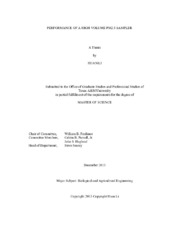| dc.description.abstract | Particulate matter (PM) is a complex mixture of extremely small particles suspended in the air. PM_(2.5) is the fraction of particles suspended in the air with diameters that are nominally 2.5 μm and smaller. For regulatory purposes, PM_(2.5) concentrations can be measured by a Federal Equivalent Method (FEM) sampler. Environmental Protection Agency (EPA) designates PM_(2.5) samplers which meet the requirements specified in 40 Code of Federal Regulation (CFR), Part 53, Subpart F as FEM samplers.
Wind tunnels used to evaluate PM2.5 samplers must satisfy the performance requirements for wind velocity uniformity and aerosol concentration uniformity. For wind velocity uniformity, mean wind speeds in the test section were within ±10 percent of the target (2 and 24 km/hr wind speeds), and the variation at any test point in the test section did not exceed 10% of the measured mean. For concentration uniformity, the coefficient of variation of the concentration was lower than 10% at 2 and 24 km/hr wind speeds.
The PM_(2.5) sampler and two isokinetic samplers were placed into the wind tunnel and challenged with ammonium fluorescein solid particles with diameter from 1.5 μm to 4 μm at wind speed of 2 and 24 km/hr. The sampling effectiveness for each particle size can be obtained by fluorometric analysis. Based on the results of full wind tunnel tests and particle distribution data for aerodynamic particle sizer, a preliminary sampling effectiveness curve was determined by fitting a lognormal curve to the observed solid aerosol sampling effectiveness data by minimizing the sum of squared error between the predicted effectiveness and the data from full wind tunnel tests.
The cutpoints for 2 and 24 km/hr wind speed were 3.08 μm and 3.29 μm, respectively, out of the range of 2.5±0.2 μm, and mass concentration ratios (Rc) were larger than 1.05 except for the idealized fine aerosol size distribution. Therefore, the candidate sampler did not pass the full wind tunnel test.
The possible reason that the high volume PM2.5 sampler failed to pass full wind test was the velocity inside the nozzle was lower than necessary to separate large particles from the sample flow. | en |


